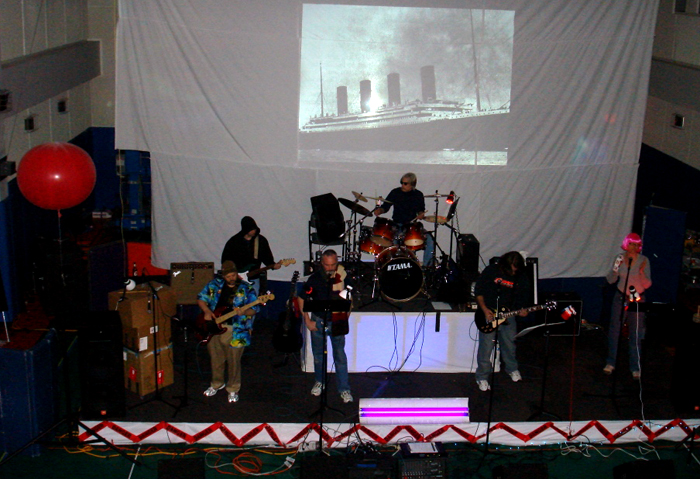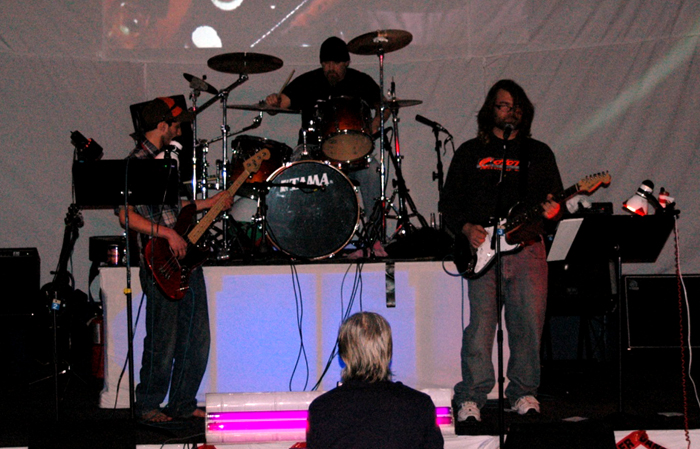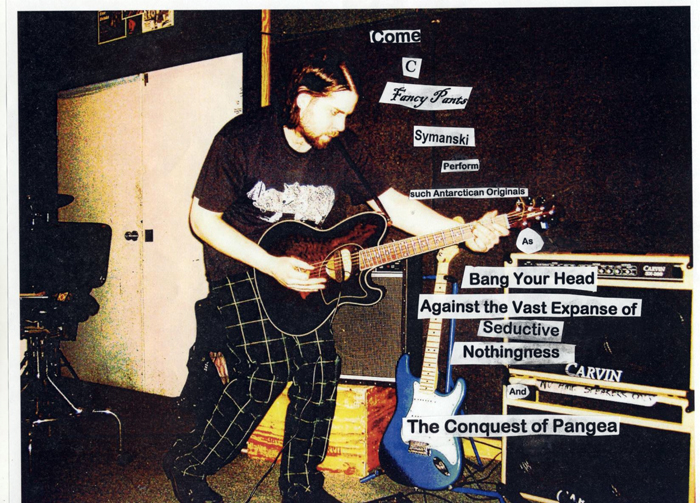
Photo Credit: Heidi Lim |
South Pole band The ReTardis performs at Pole Stock 2008 at the gym in the Elevated Station. Five bands and two solo acts turned the event into a six-hour music marathon that featured everything from thrash metal to original acoustic tunes. |
We want to rock
South Pole music festival pools diverse talent for biggest show of the winter
By Jeff King, South Pole correspondent
Posted May 23, 2008
Music has a long and colorful history in Antarctica, dating back to the early explorers. In fact, some might say music is an essential part of life on the Ice.
Evidence is abundant in the U.S. Antarctic Program during the austral summer season — Icestock at McMurdo Station and New Year’s Eve at South Pole Station display some of the best amateur musical performances on this continent. This winter at South Pole, however, has already produced one memorable musical event that easily rivals either of those shows.
The winter season commenced without a music scene. There were 15 known musicians on station, but no bands had formed as late as sunset. The first band — The ReTardis (for the Dr. Who Fans) — did not come together until the end of March, with the goal of playing a live show over the station’s two-day weekend on April 26. Pole Stock 2008 was born.
The ReTardis frontman and Pole Stock mastermind, Kevin Torphy, later said, “I had no idea at that time how big a production it would turn out to be. It escalated rapidly from being a short session with a couple of bands to being Pole Stock.”
What started out as a plan for one or two bands to play a couple short sets, quickly became five bands and two solo acts playing a six-hour concert with the help of behind-the-scenes video operators, sound crew, lighting and electronics crew, stage construction team, interior decorators, security personnel, cooks, bartenders and even roadies.
Preparation and breakdown took an estimated 200 off-duty hours of work by more than half of the winter-over population, according to Torphy, not including the hundreds of hours the musicians spent practicing.
The bulk of the preparation for the concert began the day before with stage setup. The roadies and several other community volunteers pieced together a wooden stage platform in the Elevated Station’s gym and hauled the bands’ equipment to the stage. Meanwhile, a team of interior decorators made the gym look more like a concert venue.
Technology also played an important part in Pole Stock. Members of the South Pole IT department engineered a special effects package, which included a series of reversed images projected onto a screen in the rear of the stage, with two other projectors displaying patterns on either side of the images. Most of these images were historical events or influential people in world history, and changed in sync with the tempo and style of music the performers played.
A couple of electricians installed three sets of colored lights that could be synchronized to the music. One of the musicians set up an Internet broadcast so the entire concert could be heard by anyone in the world with Web access. Two winter-overs set up high-definition video cameras to record the entire event.
For the finishing touch, to create an atmosphere as close as possible to a real concert, two security guards were stationed at the front door to check tickets and pat everyone down.

Photo Credit: William Brubaker
South Pole band The House Mouse Seasonal Affective Disorder Blues Project bring the noise at Pole Stock 2008.

Photo Courtesy: Jeff King
Pole Stock 2008 included original concert flyers. This one features musician Mike Symanski, who fronted a band and performed solo.
Once the preparation was complete, the focus quickly shifted to the point of this shindig — music. The first band to perform, The Quasi-Crystalline Arbitration Project, played original music all written by winter-over Mike Symanski.
The best way to describe it accurately is in Symanski’s own words. “Its source is like a doorway to some other world. … The goal is for the music to be a medium connecting the audience to this other place, completely engaging them.
“More specifically, we all came together quite randomly and are more or less an acoustic band that plugs in playing some kind of expansive, escapist horizon-type of sound, gracefully oscillating from seductively serene sections to catchy intensity and back again.”
The ReTardis are a pop cover band spanning a wide generation range. Some of the artists they covered included Weezer, The Beach Boys, Tom Petty, REM and the Foo Fighters. This band easily led to more dancing than any other.
Triceratops: The Revenge! played all original modern rock songs. Bassist James Travis claims, “It’s been described to me as math rock. Whatever that means. I think it sounds like hippie jam rock, kinda like Radiohead got slapped upside the head by Pink Floyd.”
The House Mouse Seasonal Affective Disorder Blues Project (HMSADBP) covered blues hits from back in the day. Some of the artists they covered included Jimi Hendrix, Stevie Ray Vaughn, Cream, David Lindley and Bob Seger. In reality, though, according to frontman Tim Hayosh, “These songs are just thinly veiled excuses for me to play guitar solos. I really have to thank the guys in the band, and especially the audience, for indulging me.”
The final band was resident South Pole thrash metal ensemble Korpsicle. The only South Pole band with a slogan — Die Cold or Die Trying (in parody of rap artist 50 Cent’s first album) — Korpsicle’s frontman James Travis says, “We focus on the pain and suffering, both mental and physiological, that come with working on the Ice during winter.”
The two solo artists were Torphy and Symanski. Torphy covered three classic rock songs, including a rendition of “Space Oddity” with Hayosh on guitar and harmony vocals, while an animated video created by winter-over science lead Dana Hrubes (when he was 12 years old) of a space shuttle flying through space played on the background screen. Symanski played two original acoustic pieces, and experimented on vocals as he attempts to expand his musical repertoire.
Fifteen musicians. Seven musical acts. Six different musical genres. Such diversity can mostly be attributed to the wide variety of musical backgrounds:
There’s an Irish native who grew up playing traditional Irish music; a guitarist who started his musical endeavors in a Christian thrash metal cover band; a solo artist who compares the magical manifestation of music from the ether to Santa bringing Christmas gifts; a guitarist who has been playing longer than most of his band mates have been alive; a rocker from Detroit; a former grade school marching band member; a former violinist for the Raleigh, N.C. Civic Chamber Orchestra and Sydney-based mariachi band The Real Mexico; and a son of a professional French horn and piano playing mother and a stepfather who played trombone on tour with Woody Herman.
Seven South Pole musicians have played in other Antarctic bands, including well-known McMurdo groups Scroggin and Run Fingee Run, as well as other summer and winter bands around the continent.
“Planning for the next gig started the Sunday after Pole Stock, and our intent is to make it bigger and more spectacular,” Torphy said. “We have a crack team of scientists working on special effects … and a dedicated group of musicians busy learning new set lists.”
The next gig, the Midwinter celebration, will be June 21.







